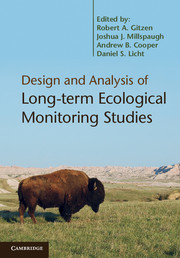Book contents
- Frontmatter
- Contents
- List of contributors
- Foreword: Ecology, management, and monitoring
- Preface
- Acknowledgments
- Abbreviations
- Section I Overview
- Section II Survey design
- 5 Spatial sampling designs for long-term ecological monitoring
- 6 Spatially balanced survey designs for natural resources
- 7 The role of monitoring design in detecting trend in long-term ecological monitoring studies
- 8 Estimating variance components and related parameters when planning long-term monitoring programs
- 9 Variance components estimation for continuous and discrete data, with emphasis on cross-classified sampling designs
- 10 Simulating future uncertainty to guide the selection of survey designs for long-term monitoring
- Section III Data analysis
- Section IV Advanced issues and applications
- Section V Conclusion
- References
- Index
- Plate Section
5 - Spatial sampling designs for long-term ecological monitoring
Published online by Cambridge University Press: 05 July 2012
- Frontmatter
- Contents
- List of contributors
- Foreword: Ecology, management, and monitoring
- Preface
- Acknowledgments
- Abbreviations
- Section I Overview
- Section II Survey design
- 5 Spatial sampling designs for long-term ecological monitoring
- 6 Spatially balanced survey designs for natural resources
- 7 The role of monitoring design in detecting trend in long-term ecological monitoring studies
- 8 Estimating variance components and related parameters when planning long-term monitoring programs
- 9 Variance components estimation for continuous and discrete data, with emphasis on cross-classified sampling designs
- 10 Simulating future uncertainty to guide the selection of survey designs for long-term monitoring
- Section III Data analysis
- Section IV Advanced issues and applications
- Section V Conclusion
- References
- Index
- Plate Section
Summary
Introduction
The spatial survey component (i.e. sampling design, Chapter 2) of a long-term ecological monitoring study dictates where sample locations are placed in a study area. The primary purpose of the spatial design is to select a sample of locations in such a way that valid scientific inferences can be made to all geographic regions of interest. The spatial design does not, in general, specify the size or shape of sample units, what or how target variables are measured, nor how sample units are revisited through time. Those specifications are left to other parts of the larger survey design. Because the spatial design dictates where samples are located, the terminology surrounding spatial designs is slightly different than that in classical finite population sampling, and reflects the fact that two-dimensional geographic locations are of primary interest. Table 5.1 translates the general definitions of a few key terms in classical sampling theory to more specific terms applicable to spatial surveys.
The purpose of this chapter is to discuss key characteristics of good spatial designs and introduce readers to some common spatial design examples. A major alternative to the designs discussed here is the generalized random tessellation stratified (GRTS) design presented in Chapter 6. In fact, a GRTS design should probably be favored over some of the designs in this chapter for implementation in real-world large-scale and long-term ecological monitoring programs due to the GRTS's added flexibility and spatial coverage assurances. Despite this, the designs of this chapter are important because they will continue to be used in studies that have focused purposes and where relatively simple designs are required. The designs of this chapter can also be combined with other designs, including GRTS, and implemented in two or more levels of nested sampling.
- Type
- Chapter
- Information
- Design and Analysis of Long-term Ecological Monitoring Studies , pp. 101 - 125Publisher: Cambridge University PressPrint publication year: 2012
- 30
- Cited by

